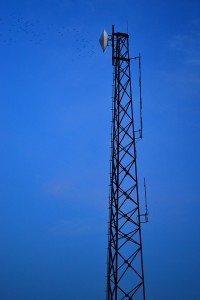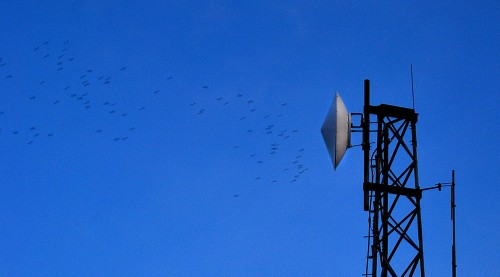The evening I shot the St. Vincent’s Catholic Church at sunset, I turned the camera in the other direction (standing in almost the same spot) and took this photo of a radio tower that stands along the railroad tracks. (Click to make it larger.)
There was something about the blue sky, the silhouetted tower and the microwave dish that looked like a flying saucer on its side that appealed to me. When I enlarged the frame, there were streaks of birds flying by (or they might have been mosquitoes; they were that big that night).
Sky would turn black with birds
That reminded me of the huge flocks of starlings that would turn the skies over Cape black at dawn and dusk in the 1960s. They would fly over the house making the most raucous screeching sounds. Then, as suddenly as they had appeared, they were gone. I stood out in the yard blasting away with my Daisy BB gun a few times, but quickly realized I’d never hit anything.
 The birds made the news in 1965, when folks in Dexter started testing positive for histoplasmosis, a lung disease attributed to fungus in the droppings and soil underneath the roosting areas used by several million starlings and blackbirds. A March 24, 1965, Missourian story said that the birds had been roosting on a 20-acre tract near the city for the past five winters.
The birds made the news in 1965, when folks in Dexter started testing positive for histoplasmosis, a lung disease attributed to fungus in the droppings and soil underneath the roosting areas used by several million starlings and blackbirds. A March 24, 1965, Missourian story said that the birds had been roosting on a 20-acre tract near the city for the past five winters.
Eight million birds near Dexter
A five-acre tract near Frisco, about 1-1/2 miles south of Essex, had also been a roosting area for an estimated three to five million birds. It was estimated that as many as eight million birds were nesting around Dexter.
I did a tongue-in-cheek story about suggestions the city had received for taking care of the bird problem. They ranged from the bizarre to the impractical. One, I recall, was to spray them with detergent from the air in the wintertime so that water would penetrate their feathers and they’d freeze to death. The problem with most of the solutions, a city official said, was “what do you do with two million dead blackbirds?”
Birds roosted on bridge
 Another story quoted Marvin Campbell, Cape County sanitation officer, as saying that the main roosting place for the Cape Girardeau starlings appeared to be the Mississippi River bridge. Evidence was found that thousands of birds frequented it. The problem wasn’t as great then as it had been in previous years when the birds roosted on State College property, he continued. (I wonder if that’s where the Home of the Birds got its name?)
Another story quoted Marvin Campbell, Cape County sanitation officer, as saying that the main roosting place for the Cape Girardeau starlings appeared to be the Mississippi River bridge. Evidence was found that thousands of birds frequented it. The problem wasn’t as great then as it had been in previous years when the birds roosted on State College property, he continued. (I wonder if that’s where the Home of the Birds got its name?)
Ridding the bridge of the birds was going to be complicated because authorities from both Missouri and Illinois would have to be involved. Songbirds were mixed in with the starlings, so mass extermination was not an option.
I suspect that development eliminated most of the nesting areas and the birds either died off or moved on.


Oh, yes, I remember the birds! They haunt me still, in the scars from histoplasmosis that I carry in my lungs from the six years I lived in Dexter during the fifties.
I was unaware of the disease until my husband and I moved to Alaska in 1969. My first trip to a doctor required a chest xray, and that revealed the scars. The doctor was very close in his guess as to where I was from. He guessed Kansas. Back then, I don’t think they even knew that the birds were the cause of the disease.
I remember the bird population explosion in Dexter and standing in line at the old Central Elementary School to get immunized for histoplasmosis. Or as we called it; our “bird shot”. I think it also made the world news with Walter Cronkite. Our three seconds of fame…I know one thing, when they flew over; you headed for cover. No explanation necessary. 😀
Ken – To my knowledge, you are correct about the origin of the “Home of the Birds” for the deep valley where the Towers were built. Until I was 10 years old (1954), we lived in the upstairs of my Grandmother’s home on North Henderson – across the street from the tennis courts. I spent a lot of my time wandering the surrounding woods and that valley became No Man’s Land when the birds were in residence. They were both loud and, shall we say, unsanitary… They were very impressive when they took flight, they truly darkened the sky.
Madeline – Bat guano is another source of the fungus, so cave explorers have a song titled “Histoplasmosis”. Maybe you might enjoy looking it up.
I had histoplasmosis. I’m thinking it was around 1970. I thought I had the flu. At first the doctor thought that as well. After a few days of high fever, I was put in the hospital for tests. The basic recovery took two months, but it was a year before I regained my previous level of energy. Needless to say, I have no love for starlings. Many people do have scars on their lungs from the disease, but never actively contracted the illness.
I remember my mother refering to the “Home of the Birds” as a place “down behind the College.”
Feb. 25, 1961 Southeast Missourian
State College’s new Magill Hall of Science stands on a hillside overlooking the wooded ravine known to generations of students on the hilltop campus as the Home of the Birds.
http://www.semissourian.com/blogs/flynch/entry/42860
Oh, no! There was a shot for the disease??? I never knew that! Too late now, I suppose. My Fairbanks doctor told me that I should never neglect a respiratory infection, as I would be susceptible to breathing problems. He was right. I used to get bronchitis or pneumonia every spring. Doesn’t happen so much anymore…don’t know why. Clean living, I guess.
As for the bat poop thing–Thanks for the interesting factoid, Mary! That’s sorta hilarious!!!
Shooting an arrow up into the passing flock was also futile … as I learned when I tried it as the evening flock winged its way to roost. This youthful effort was tried on the slopes to Broadway below Southeast Mo. Hospital. The project was abandoned after dodging a few shafts on their return to earth.
Most of us that grew up in Southeast Missouri have histoplasmosis or scarring in our lungs. Unfortunately, it also shows up in our eyes. Both have been discovered in my lungs and eyes causing my doctors to ask if I lived in Southeast Missouri. It is a small problem to put up with for the privilege of growing up in Cape!
After seeing Alfred Hitchcock’s The Birds, the massive flock flying over our house on Dorothy Street in the evening, headed to the east, had a frightening component. Groups started to roost in a row of large evergreen trees lining a neighbor’s long driveway near our house.
The neighbor prevailed upon me to come up with a way to drive the starlings from his property. We caught one in a trap, and then I set up a cassette recorder with a microphone next to the trap. I recorded the screeches made by the starling as I poked at it with a stick and made an endless loop of the tape. We would play the tape through an amplified loudspeaker as the starlings would fly over in the evening. One could see the flying starlings actually avoid the immediate area and not settle to roost. It took about a week of evenings but they avoided all trees in the immediate vicinity from that time forward.
Great fun, standing around that section down off One Mile Road, and blasting away with our shotguns, keeping the birds stirred up so they wouldn’t come into the roost!!! Seems like a truck load of old ammo was disposed of during that week or two, between the fire trucks, lights, and the national news coverage, we did have quite a row in Dexter. I lived a mile south of that roost, through the woods and could walk to school at DHS. I was tested like every student, thankfully nothing more than my pneumonia scars were found, and was negative on the shot test as well. I’m also quite cautious about stirring up any bat guano encountered while caving ANYWHERE!! Caving Softly and still bird hunting, Regards, kkr
I too lived off One Mile Road in the 1960’s and so remember the starlings flying over our house every evening about 5 pm
…I was telling some friends about the birds just this week and had not thought of them in years. Decided to try the internet and was surprised to find info about them and Dexter…
I lived just three blocks as the Eagle flies from the location where Towers now lies from the Starlings. I used to love putting on galoshes, then Tubby and I and a few other brave friends would walk over there with our B-B guns and have loads of fun shooting at them. We must not have gone down inside the trees because I don’t remember getting any bird dung anywhere other than my galoshes. We shot at them until we ran out of B-B’s or it got to dark. We hit a lot of them. The birds didn’t fly away because they were making so much noise they couldn’t hear our B-B guns going off. I guess we were also fortunate because I have never had any sort of respiratory problems so far. :-)Kids in my neighborhood called me the “Rifleman” because I was so quick at cocking and shooting my pump B-B gun. I used to stand on the back porch and wait until Chuck Conners fired his first shot. Then I would still get off ten shots before he did at the start of his show.
my brother and I were both hospitalized with the “bird poop” disease.
I missed part of my Freshman year– no year book picture.
We had to be home schooled for awhile.
Remember that there were so many roosting in the Trees at the St. Francs Hospital that they suffocated and died there.